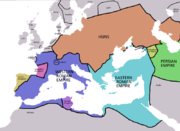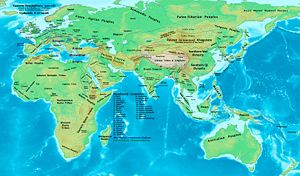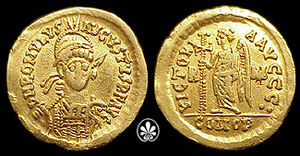5th century
2008/9 Schools Wikipedia Selection. Related subjects: General history
| Millennium: | 1st millennium |
|---|---|
| Centuries: | 4th century · 5th century · 6th century |
| Decades: | 400s 410s 420s 430s 440s 450s 460s 470s 480s 490s |
| Categories: | Births – Deaths Establishments – Disestablishments |
The 5th century is the period from 401 to 500 in accordance with the Julian calendar in Anno Domini.
Overview
This century is noted for being a time of repeated disaster and instability both internally and externally for the Western Roman Empire, which finally unravelled, and came to and end in AD 476. The west was ruled by a succession of weak emperors, and true power began to fall increasingly into the hands of powerful generals. Internal instability and pressing military problems caused by foreign invaders finally resulted in the sacking of Rome by a Visigoth army in 410. Some recovery was made in the following decades, but the Western Empire received a serious blow when another barbarian group, the Vandals occupied Carthage, capital of the extremely important province of Africa, a major supplier of wealth and grain. Attempts to retake the province were interrupted by the invasions of the Huns under Atilla. After Atilla's final defeat and death both Eastern and Western empires joined forces for a final assault on Vandal North Africa, but their campaign was a spectacular failure.
The Fall of the Western Roman Empire
The year 476 is widely understood as the point at which the Western Roman Empire came to an end. In 476 the last Western Roman Emperor, Romulus Augustus (nicknamed Augustulus "Little Augustus") was deposed by a Germanic foederati general named Odoacer. The Eastern Roman Empire finally ceased trying to prop up its hopeless Western twin, whose former lands were then divided into numerous barbarian kingdoms. The last de-facto Western Roman Emperor, Julius Nepos was murdered in Dalmatia in 480 AD. The last fragment of the Western Empire, the Domain of Soissons ruled by Duke Syagrius, was conquered by the Frankish King Clovis in 486. Roman power continued in the east however, under the rulers of Constantinople. Scholars normally refer to their empire as the Byzantine Empire, however its inhabitants considered themselves Roman throughout. Recognizable Roman culture continued to exist in the east for another 200 years before the Arab invasions of the 7th Century set off a chain of events that forever changed the face of the Eastern Roman Empire, and the entity that emerged in the next few centuries is what one might refer to as the true Medieval Byzantine Empire.
Events
- 399–412: The Chinese Buddhist monk Faxian sails through the Indian Ocean and travels throughout Sri Lanka and India to gather Buddhist scriptures.
- 406: The west frontier of the Roman Empire collapses as waves of Suevi, Alans, and Vandals cross the frozen Rhine near Mainz, and enter Gaul.
- 407: Constantine III leads mainy of the Roman military units from Britain to Gaul, occupying Arles (Arelate). This is generally seen as Rome's withdrawal from Britain.
- 410: Rome sacked by Visigoths, St. Augustine writes The City of God.
- 439: Vandals conquer Carthage.
- At some point after 440, the Anglo-Saxons settle in Britain. The traditional story is that they were invited there by Vortigern.
- 451: Huns under Attila facing the Romans and the Visigoths are defeated in the Battle of Chalons.
- 452: Pope Leo I allegedly meets personally with Attila the Hun and convinces him not to sack Rome.
- 453: Death of Attila. The Hunnic Empire is divided between his sons.
- 454: Battle of Nedao. Germanic tribes destroy the main Hunnic army and throw off Hunnic domination.
- 455: Vandals sack Rome.
-
- The city of Chichen Itza is founded in Mexico.
- 469:Death of Dengizich, last Khan of the Hunnic Empire.
- 476: August 28: Deposition of Romulus Augustulus by Odoacer: traditional date for the Fall of Rome in the West.
- 480: Assassination of Julius Nepos, the last de jure Emperor of the Western Roman Empire, in Dalmatia.
- 481: Clovis I becomes king of the Western Franks upon the death of Childeric I.
- 486: Clovis defeats Syagrius and conquers the last free remnant of the Western Roman Empire.
- 490: Battle of Mount Badon (approximate date). According to legend, British forces led by Arthur defeated the invading Saxons.
- 491: King Clovis I defeats and subjucates the Kingdom of Thuringia in Germany.
- 493: Theodoric the Ostrogoth ousts Odoacer to become king of Italy.
- 494: Northern Gaul is united under Frankish King Clovis I, founder of the Merovingian dynasty.
- 496: Battle of Tolbiac. King Clovis defeats and subjucates the Alamanni.
- Buddhism reaches Myanmar and Indonesia.
- African and Indonesian settlers reach Madagascar.
- Hopewell culture in North America ends.
Significant persons
- Agatharcos — Greek artist
- Flavius Aëtius, last of the great Roman generals
- Alaric I, king of the Visigoths that sacked Rome
- Aspar, Eastern Roman general and politician
- Attila the Hun
- Augustine of Hippo, bishop, theologian
- Bodhidharma, founder of Zen Buddhism
- John Chrysostom, Patriarch of Constantinople
- Clovis, first Frankish king to unite all the Frankish peoples
- Cyril of Alexandria, Patriarch of Alexandria
- Faxian, Chinese Buddhist monk
- Geiseric, Vandal king and founder of the Vandal kingdom in North Africa
- Hawaiiloa, discovered and settled Hawaii
- Huiyuan, Chinese Buddhist
- Hypatia of Alexandria, woman philosopher
- St. Jerome hermit, cleric, Bible translator
- Pope Leo I
- Ricimer, Western Roman general, politician and ruler
- Saint Mesrob, Armenian monk
- Niall Noigiallach, founder of one of Ireland's greatest dynasties.
- St. Patrick, completed the conversion to Christianity in Ireland
- Socrates Scholasticus, Byzantine Church historian
- Sozomen, Christian church historian
- Theoderic the Great, Ostrogothic king
- Zu Chongzhi, Chinese astronomer and mathematician
Inventions, discoveries, introductions
- Horse collar invented in China
- Heavy plow in use in Slavic lands
- Metal horseshoes become common in Gaul
- Anglo-Saxon futhorc alphabet used in England
- Armenian alphabet created by Mesrob Mashtots c. 405
Other
The gomphothere , an elephant-like species, becomes extinct.
Decades and years
|
|||||||||||||||||||||||||||||||||||||||||||||||||||||||||||||||||||||||||||||||||||||||||||||||||||||||||||||||||||||||||||||||||||||||||
|
|||||||||||||||||||||||||||||||||||||||||||||||||||||||||||||||||||||||||||||||||||||||||||||||||||||||||||||||||||||



